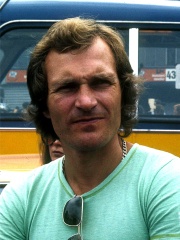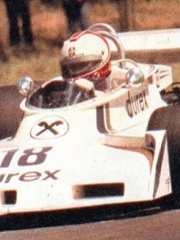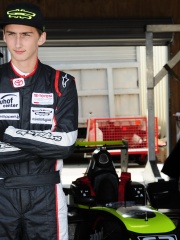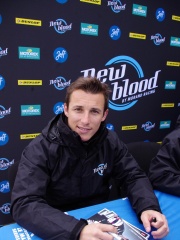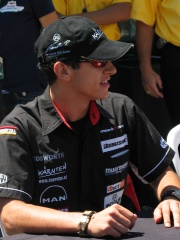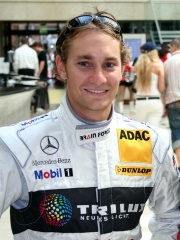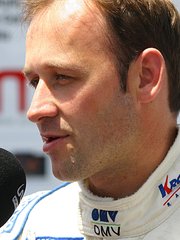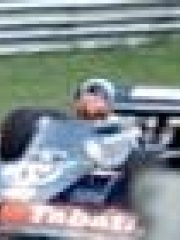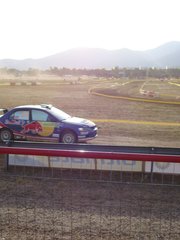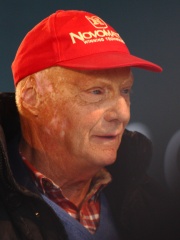
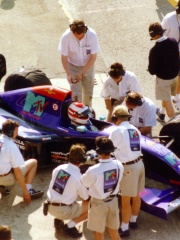
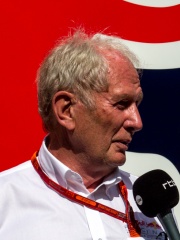
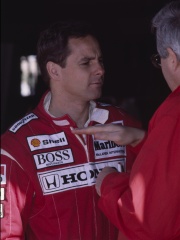
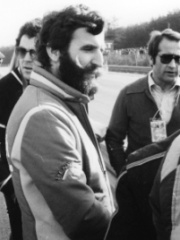

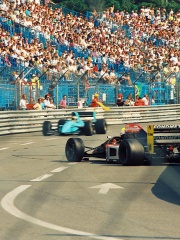
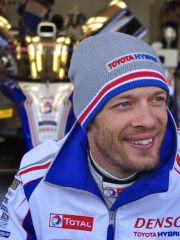
The Most Famous
RACING DRIVERS from Austria
This page contains a list of the greatest Austrian Racing Drivers. The pantheon dataset contains 1,080 Racing Drivers, 21 of which were born in Austria. This makes Austria the birth place of the 16th most number of Racing Drivers behind Belgium, and Netherlands.
Top 10
The following people are considered by Pantheon to be the top 10 most legendary Austrian Racing Drivers of all time. This list of famous Austrian Racing Drivers is sorted by HPI (Historical Popularity Index), a metric that aggregates information on a biography's online popularity. Visit the rankings page to view the entire list of Austrian Racing Drivers.

1. Niki Lauda (1949 - 2019)
With an HPI of 81.34, Niki Lauda is the most famous Austrian Racing Driver. His biography has been translated into 71 different languages on wikipedia.
Andreas Nikolaus "Niki" Lauda (22 February 1949 – 20 May 2019) was an Austrian racing driver, motorsport executive, and aviation entrepreneur, who competed in Formula One from 1971 to 1979 and from 1982 to 1985. Lauda won three Formula One World Drivers' Championship titles and—at the time of his retirement—held the record for most podium finishes (54); he won 25 Grands Prix across 13 seasons, and remains the only driver to have won a World Drivers' Championship with both Ferrari and McLaren. Born and raised in Vienna, Lauda was the grandson of local industrialist Hans Lauda. Starting his career in karting, he progressed to Formula Vee and privateer racing in the late 1960s. After his career stalled, Lauda took out a £30,000 bank loan and secured a place in European Formula Two with March Engineering in 1971, making his Formula One debut with the team at the Austrian Grand Prix. He was promoted to a full-time seat in 1972, ending the season with a non-classified championship finish, while winning the British Formula Two Championship. Lauda moved to BRM for the 1973 season, scoring his maiden points finish in Belgium and earning a seat with Ferrari the following year alongside Clay Regazzoni. Lauda took his maiden podium in his debut for Ferrari, and his maiden victory three races later at the Spanish Grand Prix. After winning five Grands Prix in his 1975 campaign, Lauda won his first title, becoming the first Ferrari-powered World Drivers' Champion in 11 years. While leading the 1976 championship—amid a fierce title battle with James Hunt—Lauda was seriously injured during the German Grand Prix at the Nürburgring, suffering severe burns and other life-changing injuries when his Ferrari 312T2 caught fire during a crash. He returned to racing six weeks later at the Italian Grand Prix, eventually losing the title to Hunt by one point. Lauda remained at Ferrari in 1977, winning several races on the way to his second championship and clinching the title at the United States Grand Prix. He left Ferrari, where he was replaced by Gilles Villeneuve, and signed with Brabham in 1978, achieving podiums in every race he finished that season, with victories in Sweden and Italy. Amid a winless 1979 season for Brabham, which had moved to Ford Cosworth V8 engines, Lauda left the team after the Italian Grand Prix, and took a two-year hiatus from racing. He returned with McLaren in 1982, winning multiple races. After a winless 1983 campaign, Lauda was partnered by Alain Prost the following season, where he beat Prost to his third title by a record half-point. With seven years between his second and third championships, Lauda holds the record for the longest period in the history of the sport between World Championship victories, breaking Jack Brabham's record of six. Lauda retired after the 1985 season—taking his final victory at the Dutch Grand Prix—having achieved 25 race wins, 24 pole positions, 24 fastest laps, and 54 podiums in Formula One. Outside of Formula One, Lauda won the Nürburgring 24 Hours in 1973 with Alpina, and the inaugural BMW M1 Procar Championship in 1979 with Project Four. In aviation, Lauda founded and managed three airlines: Lauda Air from 1985 to 1999, Niki from 2003 to 2011, and Lauda from 2016 onwards. He returned to Formula One in an advisory role at Ferrari in 1993, and was the team principal of Jaguar from 2001 to 2002. From 2012 until his death, Lauda was the non-executive chairman and co-owner of Mercedes, winning six consecutive World Constructors' Championships with the team from 2014 to 2019. Lauda was inducted into the International Motorsports Hall of Fame in 1993.

2. Roland Ratzenberger (1960 - 1994)
With an HPI of 71.76, Roland Ratzenberger is the 2nd most famous Austrian Racing Driver. His biography has been translated into 42 different languages.
Roland Walter Ratzenberger (German: [ˈroːlant ˈratsn̩bɛrɡɐ]; 4 July 1960 – 30 April 1994) was an Austrian racing driver, who competed in Formula One at three Grands Prix in 1994. Born and raised in Salzburg, Ratzenberger began his racing career as a protégé of Walter Lechner, joining the Lechner Racing School at the Salzburgring upon graduating from technical school, aged 18. Ratzenberger progressed to Formula Ford in 1983, winning multiple national and continental titles, as well as the Festival in 1986. Ratzenberger balanced his next two seasons between touring car racing and Formula Three; he contested the World Touring Car Championship in 1987 with Schnitzer, achieving four podium finishes in 10 races whilst driving the BMW E30 M3. After finishing third in the 1989 British Formula 3000 Championship and retiring from his 24 Hours of Le Mans debut, Ratzenberger moved into Japanese motorsport with Toyota. Amongst competing in World Sportscar, All-Japan Sports Prototype, Japanese Touring Car and Japanese Formula 3000, Ratzenberger also entered four further editions of Le Mans from 1990 to 1993, winning the C2 class at the latter in the Toyota 93C-V with SARD. Ratzenberger signed for Simtek in 1994, making his Formula One debut at the Brazilian Grand Prix, where he did not qualify. He made his only Grand Prix start at the subsequent Pacific Grand Prix, finishing 11th after starting 26th. During qualifying for the San Marino Grand Prix at Imola, Ratzenberger died as the result of a basilar skull fracture sustained in an accident at the Villeneuve Curva, colliding with a concrete barrier at 225 km/h (140 mph) in his Simtek S941. He was the first fatality in the Formula One World Championship since Riccardo Paletti in 1982. The weekend became notorious for the fatal accident of Ayrton Senna the following day, with both deaths leading to widespread safety reforms and the re-establishment of the Grand Prix Drivers' Association.

3. Helmut Marko (b. 1943)
With an HPI of 70.49, Helmut Marko is the 3rd most famous Austrian Racing Driver. His biography has been translated into 30 different languages.
Helmut Marko (born 27 April 1943) is an Austrian former racing driver and motorsport executive who competed in Formula One at 10 Grands Prix from 1971 to 1972. In endurance racing, Marko won the 24 Hours of Le Mans in 1971 with Martini. He founded RSM Marko in 1984, which later became the Red Bull Junior Team; from 2005 to 2025, he served as an adviser to Red Bull Racing and its related teams in Formula One, winning six World Constructors' Championship titles between 2010 and 2023. Born and raised in Austria, Marko progressed to sportscar racing by the late-1960s after completing his doctorate in law at the University of Graz. Finding success in the European Touring Car Championship and becoming a class winner at the 1970 24 Hours of Le Mans with Martini, Marko progressed to the premier class the following year and won the race in then-record distance alongside Gijs van Lennep. Less than two months later, Marko debuted in Formula One with Bonnier at the German Grand Prix, driving a privateer McLaren M7C. He joined BRM for the remainder of the 1971 season, and retained his seat in 1972. Marko was seriously injured during the 1972 French Grand Prix, when debris projected by the March of Ronnie Peterson pierced his visor and left him permanently blinded in his left eye, ending his racing career aged 29. Upon retiring from motor racing, Marko moved into team and driver management, founding RSM Marko in 1984, which became the Red Bull Junior Team in 1999. With Red Bull, Marko oversaw the development of two Formula One World Drivers' Champions—Sebastian Vettel and Max Verstappen—and was an adviser to Red Bull Racing from 2005 onwards, winning six World Constructors' Championships with the team; the graduates of his development programme have won a combined eight World Drivers' Championships and 137 Grands Prix. He retired from his management roles at the end of 2025.

4. Gerhard Berger (b. 1959)
With an HPI of 68.93, Gerhard Berger is the 4th most famous Austrian Racing Driver. His biography has been translated into 43 different languages.
Gerhard Berger (German pronunciation: [ˈɡeːɐ̯.haʁt ˈbɛʁ.ɡɐ]; born 27 August 1959) is an Austrian former racing driver and motorsport executive, who competed in Formula One from 1984 to 1997. Berger won ten Formula One Grands Prix across 14 seasons. Berger competed in Formula One for 14 seasons, twice finishing third overall in the championship in 1988 and 1994 with Ferrari. With 210 starts, Berger is amongst the most experienced Formula One drivers of all time. His first and last victories were also the first and last victories for the Benetton team, with eleven years separating them. He was also a race winner with Ferrari and with McLaren. When at McLaren, Berger drove alongside Ayrton Senna, contributing to the team's 1990 and 1991 constructors' titles. Berger retired in 1997 with ten wins, 12 pole positions, 21 fastest laps and 48 podiums in Formula One. Berger returned to Formula One in 2006 as the co-owner of Toro Rosso, before selling his 50% share back to Red Bull at the end of the 2008 season.
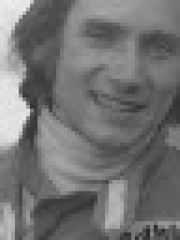
5. Helmuth Koinigg (1948 - 1974)
With an HPI of 64.91, Helmuth Koinigg is the 5th most famous Austrian Racing Driver. His biography has been translated into 24 different languages.
Helmut Koinigg (3 November 1948 – 6 October 1974) was an Austrian racing driver who died in a crash in the 1974 United States Grand Prix, in his second Grand Prix start.

6. Harald Ertl (1948 - 1982)
With an HPI of 59.56, Harald Ertl is the 6th most famous Austrian Racing Driver. His biography has been translated into 20 different languages.
Harald Ertl (31 August 1948 – 7 April 1982) was an Austrian racing driver and motorsport journalist. He was born in Zell am See and attended the same school as Grand Prix drivers Jochen Rindt, Helmut Marko and Niki Lauda. Ertl sported an 'Imperial'-style moustache and full beard. He worked his way through the German Formula Vee and Super Vee, and then on to Formula Three, before a successful switch to Touring Cars. During this period, he gained sufficient sponsorship to enter Formula One, where he drove with various outfits between 1975 and 1980. Ertl was one of the four drivers who helped to get Niki Lauda out of his burning Ferrari in the 1976 German Grand Prix. Ertl was killed in an aeroplane crash in 1982, when the small plane he was travelling in suffered from engine failure.

7. Franz Tost (b. 1956)
With an HPI of 58.02, Franz Tost is the 7th most famous Austrian Racing Driver. His biography has been translated into 23 different languages.
Franz Tost (born 20 January 1956 in Trins, Austria) is a former racing driver and the former team principal of the Scuderia AlphaTauri Formula One team, a role he departed from at the end of the 2023 Formula One season.

8. Karl Wendlinger (b. 1968)
With an HPI of 57.92, Karl Wendlinger is the 8th most famous Austrian Racing Driver. His biography has been translated into 27 different languages.
Karl Wendlinger (German pronunciation: [kaʁl ˈvɛndlɪŋɐ]; born 20 December 1968) is an Austrian professional racing and former Formula One driver.

9. Alexander Wurz (b. 1974)
With an HPI of 57.04, Alexander Wurz is the 9th most famous Austrian Racing Driver. His biography has been translated into 44 different languages.
Alexander Georg Wurz (German pronunciation: [ˌalɛˈksandɐ ˈɡeː.ɐ̯k vʊʁt͡s]; born 15 February 1974) is an Austrian former racing driver, motorsport executive and businessman, who competed in Formula One between 1997 and 2007. In endurance racing, Wurz is a two-time winner of the 24 Hours of Le Mans in 1996 and 2009 with Joest and Peugeot, respectively. Amongst several test driver roles, Wurz competed at 69 Grands Prix across six seasons with Benetton, McLaren, and Williams; he achieved three podiums. Since his retirement, he has been a commentator for television, as well as chairman of the Grand Prix Drivers' Association. and occasionally a driver steward.

10. Jo Gartner (1954 - 1986)
With an HPI of 55.99, Jo Gartner is the 10th most famous Austrian Racing Driver. His biography has been translated into 18 different languages.
Josef Anton Gartner (24 January 1954 – 1 June 1986) was a Formula One and sports car endurance driver from Austria. After a successful lower formula career, including a win in the Formula Two Pau Grand Prix, he participated in eight Formula One Grands Prix for Osella during the 1984 season, scoring no points. He was killed in an accident at the 1986 24 Hours of Le Mans.
People
Pantheon has 21 people classified as Austrian racing drivers born between 1939 and 2001. Of these 21, 15 (71.43%) of them are still alive today. The most famous living Austrian racing drivers include Helmut Marko, Gerhard Berger, and Franz Tost. The most famous deceased Austrian racing drivers include Niki Lauda, Roland Ratzenberger, and Helmuth Koinigg. As of April 2024, 2 new Austrian racing drivers have been added to Pantheon including Manfred Stohl, and Andreas Aigner.
Living Austrian Racing Drivers
Go to all RankingsHelmut Marko
1943 - Present
HPI: 70.49
Gerhard Berger
1959 - Present
HPI: 68.93
Franz Tost
1956 - Present
HPI: 58.02
Karl Wendlinger
1968 - Present
HPI: 57.92
Alexander Wurz
1974 - Present
HPI: 57.04
Dieter Quester
1939 - Present
HPI: 55.59
Hans Binder
1948 - Present
HPI: 54.89
Ferdinand Zvonimir von Habsburg
1997 - Present
HPI: 51.74
Christian Klien
1983 - Present
HPI: 51.33
Patrick Friesacher
1980 - Present
HPI: 49.38
Mathias Lauda
1981 - Present
HPI: 47.42
Manfred Stohl
1972 - Present
HPI: 42.03
Deceased Austrian Racing Drivers
Go to all RankingsNiki Lauda
1949 - 2019
HPI: 81.34
Roland Ratzenberger
1960 - 1994
HPI: 71.76
Helmuth Koinigg
1948 - 1974
HPI: 64.91
Harald Ertl
1948 - 1982
HPI: 59.56
Jo Gartner
1954 - 1986
HPI: 55.99
Otto Stuppacher
1947 - 2001
HPI: 53.21
Newly Added Austrian Racing Drivers (2025)
Go to all RankingsOverlapping Lives
Which Racing Drivers were alive at the same time? This visualization shows the lifespans of the 6 most globally memorable Racing Drivers since 1700.

